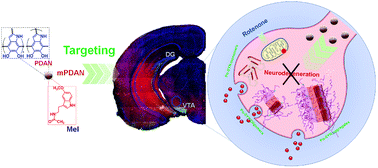Melatonin/polydopamine nanostructures for collective neuroprotection-based Parkinson's disease therapy†
Abstract
Parkinson's disease (PD) is characterized by the loss of dopaminergic neurons in the substantia nigra and localized deposition of cytoplasmic fibrillary inclusions as Lewy bodies in the brain. The aberrant phosphorylation of α-synuclein at serine 129 is the key process on its early onset, which alters the cellular conformation to oligomers and insoluble aggregates, underpinning cellular oxidative stress and mitochondrial dysfunction, leading to devastating PD synucleinopathy. The multiple neuroprotective roles of dopamine and melatonin are often demonstrated separately; however, this approach suffers from low and short bioavailability and is associated with side-effects upon overdosing. Herein, highly pleiotropic melatonin-enriched polydopamine nanostructures were fabricated, which showed efficient brain tissue retention, sustainable and prolonged melatonin release, and prevented neuroblastoma cell death elicited by Parkinson's disease-associated and mitochondrial damaging stimuli. The synergistic neuroprotection re-established the mitochondrial membrane potential, reduced the generation of cellular reactive oxygen species (ROS), inhibited the activation of both the caspase-dependent and independent apoptotic pathways, and exhibited an anti-inflammatory effect. At the molecular level, it suppressed α-synuclein phosphorylation at Ser 129 and reduced the cellular deposition of high molecular weight oligomers. The therapeutic assessment on ex vivo organotypic brain slice culture, and in vivo experimental PD model confirmed the superior brain targeting, collective neuroprotection on dopaminergic neurons with reduced alpha-synuclein phosphorylation and deposition in the hippocampal and substantia nigra region of the brain. Thus, nature-inspired melatonin-enriched polydopamine nanostructures conferring collective neuroprotective effects attributes activation of anti-oxidative, anti-inflammatory, and anti-apoptotic pathways may be superior for application in a nanomedicine-based PD therapy.



 Please wait while we load your content...
Please wait while we load your content...